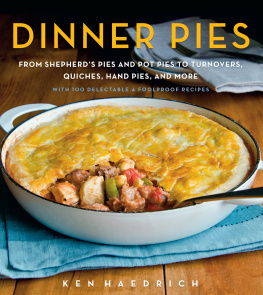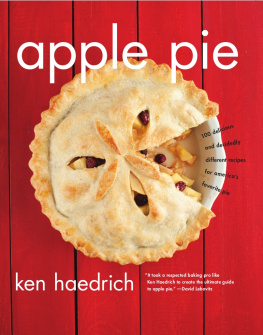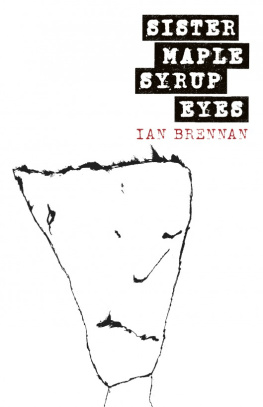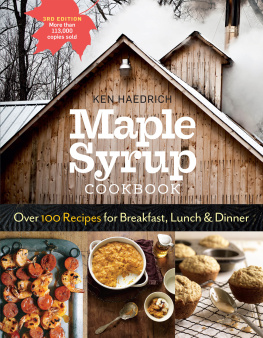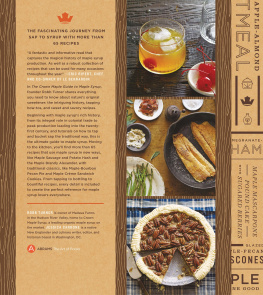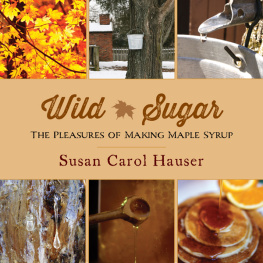Dedicated to the hardworking sugarmakers of North America, the men and women who work so diligently to maintain the traditions and goodness of real maple syrup
Contents
Foreword to the 1st Edition
In the traditions of the past, Ken Haedrich and I would be exchanging recipes over the back fence, as good friends and neighbors used to do. And judging from the recipes Ken has gathered here in the Maple Syrup Cookbook, a gratifying exchange it would have been.
Instead of over the back fence, Ken and I have had our kitchen talks over the phone for many years now. And weve exchanged our share of letters. In addition, Ive followed his cooking column in Country Journal magazine, as well as the recipes and articles he has published elsewhere. Through it all, Ive come to know Ken as a fine American home cook who has great enthusiasm and a respect for simple, wholesome ingredients an attitude that stands out clearly in his writing and recipes.
Recently, I visited Ken for the first time at his home in the quiet woods of New Hampshire, where he lives with his young family. When I sat down in Kens kitchen and ate his good warm biscuits and pies including several of the ones youll find here it was just the kind of homey visit with a friend that we all love.
With any luck, Ill be back to visit Ken soon. But in the meantime, if I cant eat his own good maple pies, cakes, cookies, and breakfasts, I can at least keep a copy of this book close by, to make them for myself.
It seems most appropriate that Ken, with his fondness for pure and simple ingredients, should write this maple syrup cookbook. Maple syrup is one of Americas most delicious natural foods, and Ken has done a great job of giving us recipes that let the wonderful flavor of maple syrup come through.
Marion Cunningham
Author of The Fannie Farmer Cookbook
Preface
The book you are holding in your hands is a far cry from the first 48-page, black-on-white edition of a self-published collection I originally called The Maple Syrup Baking and Dessert Cookbook.
The year was 1985. I had been living in New Hampshire for five years, working as the chief cook and bottle washer at a group home for children whod gotten off to a rough start in life. I loved the work, the pay not so much, so I thought Id try to make a few extra bucks by self-publishing a book of recipes about a native food product Id grown quite smitten with during my tenure: pure maple syrup.
Before long, I was loading cases of books into the back of my pickup and, on my days off, Id schlep them store to store across New England. Times being tight, I would often sleep in my truck, though I cant say that the sight of a groggy, 6-foot 4-inch mountain man in a bulky parka and full beard did much to charm the regions bookstore owners. Or help me sell many books.
In time, the good publisher of this most recent edition would rescue me from my self-publishing misery. And I, a better writer-cook than publisher, would stick to what I knew best: writing cookbooks.
Thirty years and fifteen cookbooks later, Ive moved away from New England, but Im no less smitten than I was when I wrote, in the original edition, that I love the flavor, the smell, and the color of pure maple syrup, a combination of sensual pleasures nobody has been able to capture with artificial ingredients.
If anything, Im even more in awe of maple syrup and the hardworking farmers who skillfully produce it each spring when freezing nights begin to alternate with warming days than I ever was. I may not have the need or luxury of using it as freely as I did when I was cooking full-time in New Hampshire, but lucky for us cooks the trick to using maple syrup in the kitchen is often less about quantity than it is about compatibility.
More than a few of the recipes in this collection will illustrate my point nicely. Here youll find plenty of pancakes, waffles, and French toast favorites where only a generous dousing will do. But youll also discover how grilled salmon is exquisite served with a lightly mapled mango salsa; how glazed Brussels sprouts take on a whole new flavor dimension with just a spoonful or two of syrup; and how Maple-Onion Marmalade, Spicy Sweet-and-Sour Dressing, Sweet Potato and Bacon Bisque, and dozens more dishes need only a light touch to create maple magic.
In large measure or small, thats what this book is all about: sharing my favorite ways to use genuine maple syrup in the kitchen. Its a journey I look forward to taking with you. Along the way, Ill tempt you with some gorgeous photographs, share my maple cooking tips and maple syrup lore, celebrate syrup-making traditions, and introduce you to the sugarmakers the farmers whose dedication to their craft makes it all possible.
Heres hoping that all of the maple recipes in this book, not to mention any of your own adaptations they might inspire, give you and yours as much pleasure as they have me and mine.
Ken Haedrich
one
Maple from Tree to Table
Though it is widely believed that the Native Americans were experienced sugarmakers long before European settlers arrived in North America, when and how they learned to make maple syrup is a mystery. A Native American legend has it that there was once a time when sap issued from the maple tree in a nearly pure syrup form, something that a formidable god by the name of Ne-naw-Bozhoo decided to bring to a halt. Anticipating, no doubt correctly, that syrup thus had would be too easily taken for granted, he diluted it with water. Sugarmakers have been boiling the water out of sap ever since, in the pursuit of pure maple syrup.
The Native Americans are likely to have converted most of their maple syrup to maple sugar. Liquid storage vessels were few, and maple sugar was far easier to store and transport. They put their Indian sugar into specially made birch bark boxes known as mokuks and carried containers of it to market. Along with these larger blocks of maple sugar, which they sold or traded, the Native Americans made molded sugar candies. The molds were, as one observer noted, cut from soft wood and greased before the sirup was put into them so that it could easily be taken out. These molds were in [the] shapes of various animals, also of men, and of the moon and stars, originality being sought.
Colonial Innovations
Early settlers in the Americas brought their innovations to the sugar-making art. Foremost among these innovations were iron and copper kettles, which proved to be far less perishable than the wooden and clay troughs the Native Americans used for boiling sap. Early settlers realized that the Native American way of tapping maples by cutting deep gashes into the bark not only wasted sap but also injured the trees. So they took to drilling tapholes with an auger.


